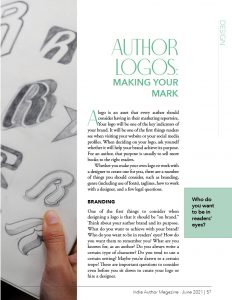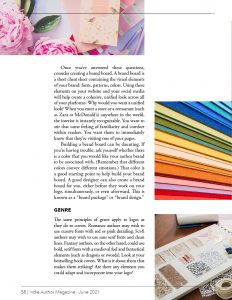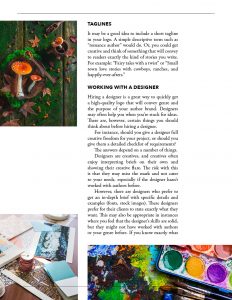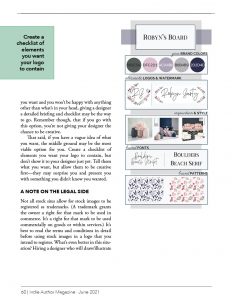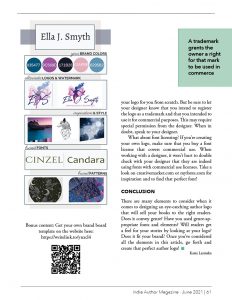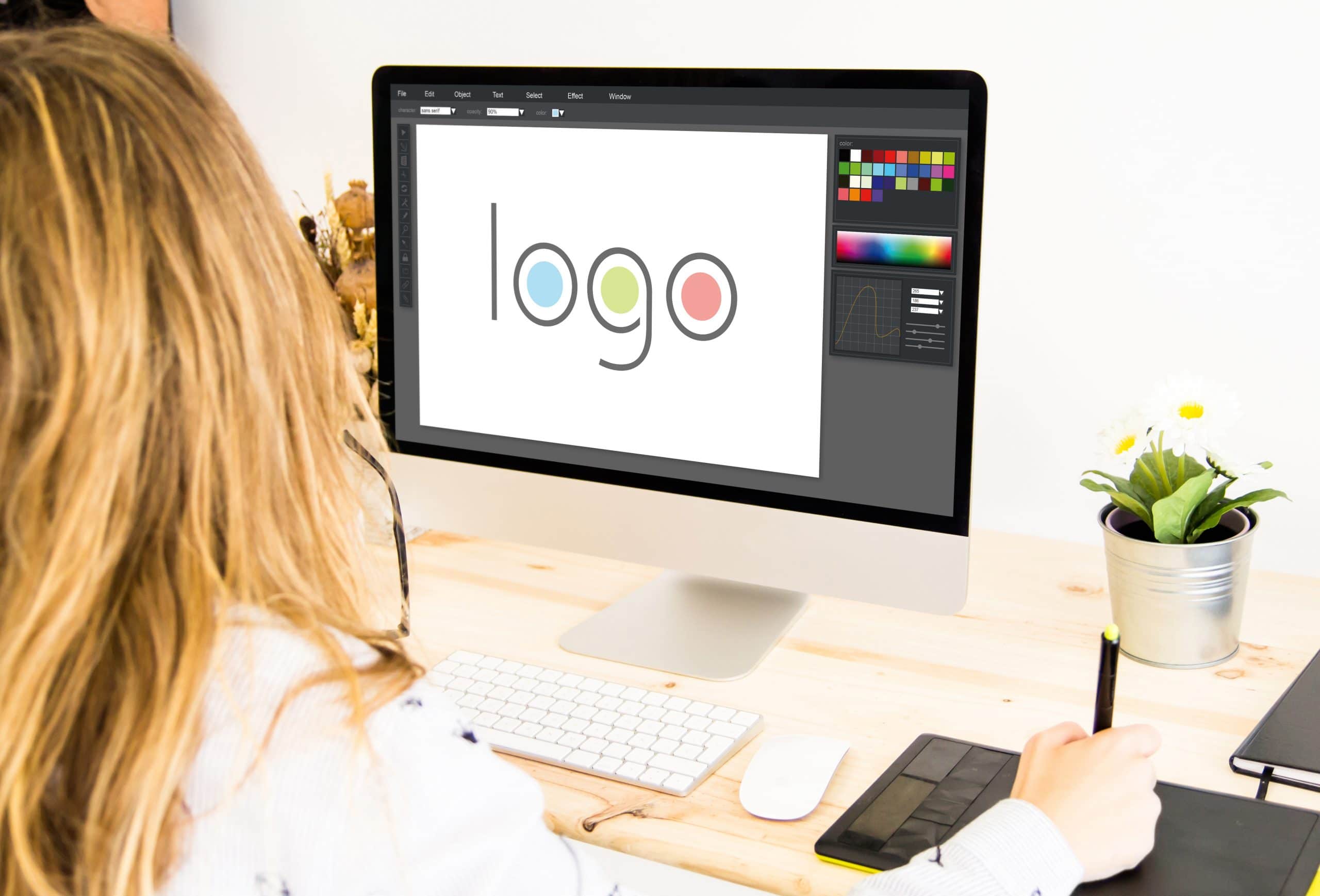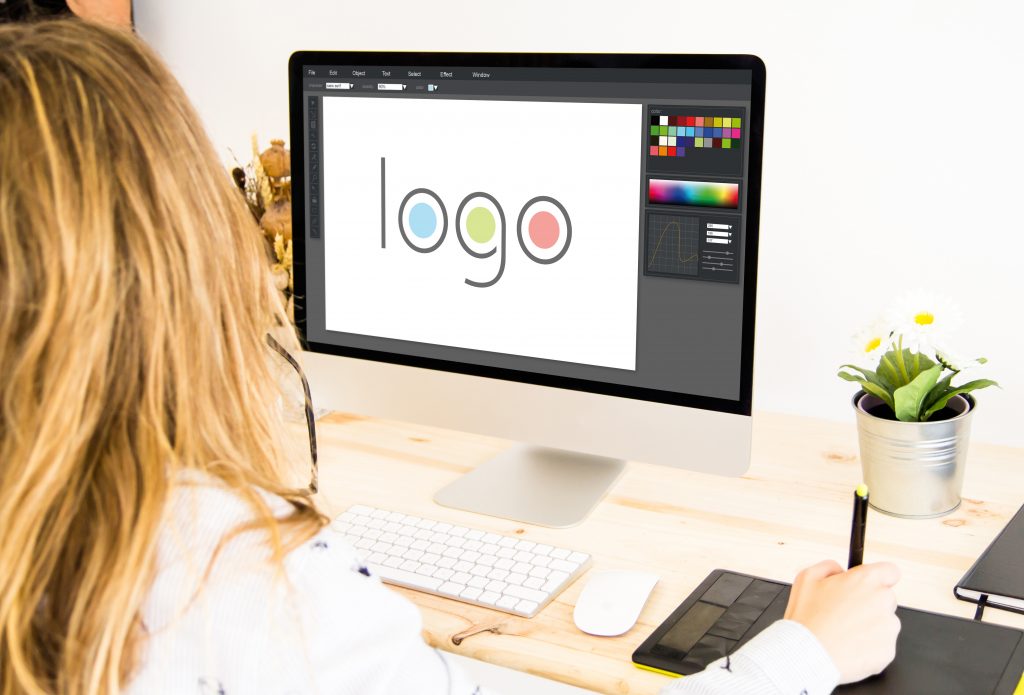
A logo is an asset that every author should consider having in their marketing repertoire. Your logo will be one of the key indicators of your brand. It will be one of the first things readers see when visiting your website or your social media profiles.
When deciding on your logo, ask yourself whether it will help your brand achieve its purpose. For an author, that purpose is usually to sell more books to the right readers.
Whether you make your own logo or work with a designer to create one for you, there are a number of things you should consider, such as branding, genre (including use of fonts), taglines, how to work with a designer, and a few legal questions.
Branding
One of the first things to consider when designing a logo is that it should be “on brand.” Think about your author brand and its purpose. What do you want to achieve with your brand? Who do you want to be in readers’ eyes? How do you want them to remember you? What are you known for, as an author? Do you always write a certain type of character? Do you tend to use a certain setting? Maybe you’re drawn to a certain trope? These are important questions to consider even before you sit down to create your logo or hire a designer.
Once you’ve answered these questions, consider creating a brand board. A brand board is a short cheat sheet containing the visual elements of your brand: fonts, patterns, colors. Using these elements on your website and your social media will help create a cohesive, unified look across all of your platforms. Why would you want a unified look? When you enter a store or a restaurant (such as Zara or McDonald’s) anywhere in the world, the interior is instantly recognizable. You want to stir that same feeling of familiarity and comfort within readers. You want them to immediately know that they’re visiting one of your pages.
Building a brand board can be daunting. If you’re having trouble, ask yourself whether there is a color that you would like your author brand to be associated with. (Remember that different colors convey different emotions.)
That color is a good starting point to help build your brand board. A good designer can also create a brand board for you, either before they work on your logo, simultaneously, or even afterward.
This is known as a “brand package” or “brand design.”
Genre
The same principles of genre apply to logos as they do to covers. Romance authors may wish to use cursive fonts with red or pink detailing. Sci-fi authors may wish to use sans serif fonts and clean lines. Fantasy authors, on the other hand, could use bold, serif fonts with a medieval feel and fantastical elements (such as dragons or swords).
Look at your bestselling book covers. What is it about them that makes them striking? Are there any elements you could adapt and incorporate into your logo?
Taglines
It may be a good idea to include a short tagline in your logo. A simple descriptive term such as “romance author” would do. Or, you could get creative and think of something that will convey to readers exactly the kind of stories you write. For example: “Fairy tales with a twist” or “Small town love stories with cowboys, ranches, and happily-ever-afters.”
Working with a Designer
Hiring a designer is a great way to quickly get a high-quality logo that will convey genre and the purpose of your author brand. Designers may often help you when you’re stuck for ideas. There are, however, certain things you should think about before hiring a designer.
For instance, should you give a designer full creative freedom for your project, or should you give them a detailed checklist of requirements?
The answers depend on a number of things.
Designers are creatives, and creatives often enjoy interpreting briefs on their own and showing their creative flare. The risk with this is that they may miss the mark and not cater to your needs, especially if the designer hasn’t worked with authors before.
However, there are designers who prefer to get an in-depth brief with specific details and examples (fonts, stock images). These designers prefer for their clients to state exactly what they want. This may also be appropriate in instances where you feel that the designer’s skills are solid, but they might not have worked with authors or your genre before.
If you know exactly what you want and you won’t be happy with anything other than what’s in your head, giving a designer a detailed briefing and checklist may be the way to go. Remember though, that if you go with this option, you’re not giving your designer the chance to be creative.
That said, if you have a vague idea of what you want, the middle ground may be the most viable option for you.
Create a checklist of elements you want your logo to contain, but don’t show it to your designer just yet. Tell them what you want, but allow them to be creative first—they may surprise you and present you with something you didn’t know you wanted.
A Note on the Legal Side
Not all stock sites allow for stock images to be registered as trademarks. (A trademark grants the owner a right for that mark to be used in commerce. It’s a right for that mark to be used commercially on goods or within services.) It’s best to read the terms and conditions in detail before using stock images in a logo that you intend to register. What’s even better in this situation? Hiring a designer who will draw/illustrate your logo for you from scratch. But be sure to let your designer know that you intend to register the logo as a trademark and that you intended to use it for commercial purposes. This may require special permission from the designer. When in doubt, speak to your designer.
What about font licensing? If you’re creating your own logo, make sure that you buy a font license that covers commercial use. When working with a designer, it won’t hurt to double check with your designer that they are indeed using fonts with commercial use licenses. Take a look on creativemarket.com or myfonts.com for inspiration and to find that perfect font!
Conclusion
There are many elements to consider when it comes to designing an eye-catching author logo that will sell your books to the right readers. Does it convey genre? Have you used genre-appropriate fonts and elements? Will readers get a feel for your stories by looking at your logo? Does it fit your brand? Once you’ve considered all the elements in this article, go forth and create that perfect author logo!
